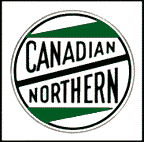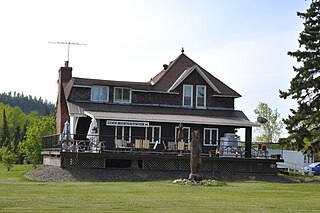
Thunder Bay is a city in and the seat of Thunder Bay District, Ontario, Canada. It is the most populous municipality in Northwestern Ontario and the second most populous municipality in Northern Ontario; its population is 108,843 according to the 2021 Canadian Census. Located on Lake Superior, the census metropolitan area of Thunder Bay has a population of 123,258 and consists of the city of Thunder Bay, the municipalities of Oliver Paipoonge and Neebing, the townships of Shuniah, Conmee, O'Connor, and Gillies, and the Fort William First Nation.
Port Arthur was a city in Northern Ontario, Canada, located on Lake Superior. In January 1970, it amalgamated with Fort William and the townships of Neebing and McIntyre to form the city of Thunder Bay.

The Grand Trunk Railway was a railway system that operated in the Canadian provinces of Quebec and Ontario and in the American states of Connecticut, Maine, Michigan, Massachusetts, New Hampshire, and Vermont. The railway was operated from headquarters in Montreal, Quebec, with corporate headquarters in London, United Kingdom. It cost an estimated $160 million to build. The Grand Trunk, its subsidiaries, and the Canadian Government Railways were precursors of today's Canadian National Railway.

The Canadian Northern Railway (CNoR) was a historic Canadian transcontinental railway. At its 1923 merger into the Canadian National Railway, the CNoR owned a main line between Quebec City and Vancouver via Ottawa, Winnipeg, and Edmonton.

The Grand Trunk Western Railroad Company was an American subsidiary of the Canadian National Railway operating in Michigan, Illinois, Indiana, and Ohio. Since a corporate restructuring in 1971, the railroad has been under CN's subsidiary holding company, the Grand Trunk Corporation. Grand Trunk Western's routes are part of CN's Michigan Division. Its primary mainline between Chicago and Port Huron, Michigan serves as a connection between railroad interchanges in Chicago and rail lines in eastern Canada and the Northeastern United States. The railroad's extensive trackage in Detroit and across southern Michigan has made it an essential link for the automotive industry as a hauler of parts and automobiles from manufacturing plants.

The Duluth, Missabe and Iron Range Railway (DM&IR), informally known as the Missabe Road, was a railroad operating in northern Minnesota and Wisconsin that used to haul iron ore and later taconite to the Great Lakes ports of Duluth and Two Harbors, Minnesota. Control of the railway was acquired on May 10, 2004, by the Canadian National Railway (CN) when it purchased the assets of Great Lakes Transportation.

The Duluth, Winnipeg and Pacific Railway is a subsidiary railroad of Canadian National Railway (CN) operating in northern Minnesota, United States. A CN system-wide rebranding beginning in 1995 has seen the DWP logo and name largely replaced by its parent company. The DWP line is CN's connection between International Falls and Duluth, Minnesota, where the railroad connects to a short stretch of the former Duluth, Missabe and Iron Range Railway before following the former Wisconsin Central to Chicago, Illinois.

The North Shore of Lake Superior runs from Duluth, Minnesota, United States, at the western end of the lake, to Thunder Bay and Nipigon, Ontario, Canada, in the north, to Sault Ste. Marie, Ontario in the east. The shore is characterized by alternating rocky cliffs and cobblestone beaches, with forested hills and ridges through which scenic rivers and waterfalls descend as they flow to Lake Superior.
The Canada Atlantic Railway (CAR) was a North American railway located in Ontario, southwestern Quebec and northern Vermont. It connected Georgian Bay on Lake Huron with the northern end of Lake Champlain via Ottawa. It was formed in 1897 through a merger of three separate railway companies that John Rudolphus Booth had either purchased or created, beginning in 1879. The CAR was owned by Booth for eight years after its formation until he sold it to the Grand Trunk Railway (GTR) in 1904.
The Whitefish River Valley is located in the unorganized area of Thunder Bay District, Ontario, and is named for the Whitefish River that flows through it. The valley is home to several small communities that developed when land was opened for homesteading along the Port Arthur, Duluth and Western Railway line at the turn of the 20th century and many people, particularly those from Finland, settled in the area. Today it has a population of approximately 1,362.
The Whitefish River is a 45 km (28 mi) long river in Thunder Bay District in northwestern Ontario, Canada. It is in the Lake Superior drainage basin, is a tributary of the Kaministiquia River, and is in the centre of the Whitefish River Valley which is the location of several small settlements that grew along the Port Arthur, Duluth and Western Railway.

The Minneapolis, St. Paul and Sault Ste. Marie Railroad (MStP&SSM) was a Class I railroad subsidiary of the Canadian Pacific Railway in the Midwestern United States. Commonly known since its opening in 1884 as the Soo Line after the phonetic spelling of Sault, it was merged with several other major CP subsidiaries on January 1, 1961 to form the Soo Line Railroad.
Leeblain is a ghost town in the Canadian province of Ontario, located on the north shore of Gunflint Lake in the Thunder Bay District. Part of the ghost town is located within La Verendrye Provincial Park and is adjacent to the well known Boundary Waters Canoe Area Wilderness in the Boundary Waters between Canada and the United States.

The Silver Mountain Station is a historic railway station located in the Thunder Bay District, Ontario. It sits at the intersection of Highway 588 and Highway 593. Now operated as a restaurant, it was constructed in 1907 as a major station along the Port Arthur, Duluth and Western Railway. It is also currently home to the Silver Mountain and Area Historical Society.

The North Lake is a former railway station located near North Lake, Thunder Bay District, Ontario. It lies close to La Verendrye Provincial Park and to the well known Boundary Waters Canoe Area Wilderness in the Boundary Waters between Canada and the United States. It was constructed in 1907 as a major station along the Port Arthur, Duluth and Western Railway.

The Paulson Mine is a former iron ore mine located in Cook County, Minnesota, United States, 53 kilometres north-west of Grand Marais, Minnesota near the end of the historic Gunflint Trail. The Port Arthur, Duluth and Western Railway was built to the mine in 1892 to access the ore, but both the mine and railway failed.

The Gunflint and Lake Superior Railroad (G&LS) is a defunct Minnesota logging railroad that operated in the Thunder Bay District of northwestern Ontario and in Cook County of northeastern Minnesota.
Herman Finger was a lumberman who owned and operated various lumber companies that operated in Wisconsin, Minnesota, Ontario, Manitoba, and Saskatchewan. He also served as the first mayor of The Pas after its establishment in 1912.












